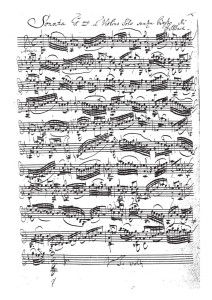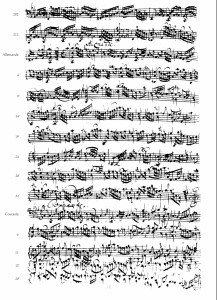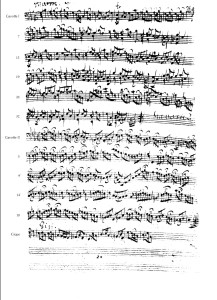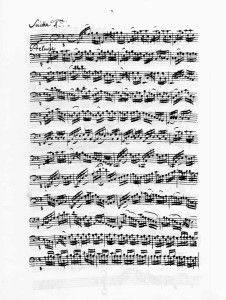A few little thoughts on playing Bach…
Since I have been persuaded – after much resistance – to work up the Bach suites again, not having performed them (apart from no 3 very occasionally) since I recorded them over 7 years ago, I thought that I might jot down a few thoughts about playing them. Of course, everybody seems to want to write about them; and since all I really want to say is that we should all get out of the way and let them speak for themselves, maybe I should shut up! But there a few stages to be passed through before one can attain that goal of getting out of the way; so maybe some words might be a bit of use to those learning or re-learning them. So here goes:
For the performer embarking on the great journey of the suites, the first requirement is – TO GET THE RIGHT EDITION! Luckily, I think this is fairly simple: the new Barenreiter, comprising the four earliest manuscripts, the first edition (interesting as a period piece), a completely clean copy, and a volume of intelligently-written text, seems to me to be the perfect edition. I suppose that if one really wants suggested bowings and fingerings, one would have to go elsewhere; but I think that’s a pity, because in these works, the fingerings and particularly the bowings one chooses are an absolutely vital part of one’s interpretation. Playing another cellist’s version makes it more of a second-hand experience. Alas and alack, Bach’s original manuscripts are lost. I use the plural, because there are so many differences between the two versions dating from Bach’s lifetime, those of his wife Anna  Magdalena and of another musician, Johann Peter Kellner, that they MUST have been copied from different sources (as many others have pointed out). I suspect, too, that neither source was a fair copy; looking at Bach’s beautiful manuscript of his sonatas and partitas for violin solo, I cannot believe that either Anna Magdalena or Kellner would have made so many errors or left us with so many questions. Bach’s writing is meticulous, the articulation mostly unmistakeable.
Magdalena and of another musician, Johann Peter Kellner, that they MUST have been copied from different sources (as many others have pointed out). I suspect, too, that neither source was a fair copy; looking at Bach’s beautiful manuscript of his sonatas and partitas for violin solo, I cannot believe that either Anna Magdalena or Kellner would have made so many errors or left us with so many questions. Bach’s writing is meticulous, the articulation mostly unmistakeable.
So in effect, each player has to make his or her own edition of the suites. Of the two copies of the cello suites mentioned above, Anna Magdalena’s is by far the more reliable; for instance, Kellner leaves out the entire Sarabande and most of the Gigue of the 5th suite! But his version has many interesting ornaments, and even some tempo and dynamic markings, which I think must have come from Bach. Looking at
 Kellner’s copy, I can’t imagine that he would have inserted these instructions himself. So it is certainly worth studying both manuscripts. When I first started learning the suites, the only version I could find was one edited by Hugo Becker, Casals’ nemesis; the first thing my teacher did was to make me put bits of white paper over all his markings! At least that edition was obviously a travesty, as one could see at first glance; later ones (such as an early Barenreiter version) were in a way more dangerous, since they purported to be urtext editions, but in fact were just reflections of the editor’s extremely subjective interpretations.
Kellner’s copy, I can’t imagine that he would have inserted these instructions himself. So it is certainly worth studying both manuscripts. When I first started learning the suites, the only version I could find was one edited by Hugo Becker, Casals’ nemesis; the first thing my teacher did was to make me put bits of white paper over all his markings! At least that edition was obviously a travesty, as one could see at first glance; later ones (such as an early Barenreiter version) were in a way more dangerous, since they purported to be urtext editions, but in fact were just reflections of the editor’s extremely subjective interpretations.
One very interesting feature of both Anna Magdalena’s and Kellner’s versions is the paucity of slurs covering all four notes of a four-note group (eg four 16ths/semiquavers in one beat). Now, it could be – as some old ‘Urtexts’ would have us believe – that this was just shorthand, and that the slur over three notes in a group, with one note definitely left out of the slur, was actually supposed to comprise all four; but I don’t believe this. It happens too often – surely they can’t have been that careless? And bowing it 3-and-1, or 1-and-3 sounds (to my ears, at least) so much more alive; the rhythms dance, rather than sounding smooth and ironed-out. But of course – this is an opinion, not a fact; as I said above, each player has to create their own edition.
(There are certainly plenty of mistakes in both versions; and one has to be on the look-out for them. For me, one occurs in the very first bar of Anna Magdalena’s copy, as seen opposite; I cannot believe that the bowing in this bar should be different from that of every other bar in the movement, when the pattern repeats so often. Perhaps I am missing some vital clue; but if so, I’ve been missing it for a long time!)
So deciding on the bowings is a lifelong task – since one will inevitably keep changing one’s mind. However, if we take that as read, and come to the actual performance of the suites, and what the listener should or should not hear, I hope that I can confidently lay out a few basic rules here. (I know that sounds didactic, and perhaps a bit presumptuous – but I feel didactic about this!) One SHOULD hear: the structure of each movement; the rhythm and correct metric accents of each dance; the humour, the pathos, the tragedy, the joy of Bach’s music. One should NOT hear – IDEAS!!!!! Poor Bach: his suites have been subjected to the most endless and bewildering array of theories about this and that aspect of them – mostly rubbish. Perhaps I should admit here that I too have a ‘theory’ about the story behind the suites, as I wrote in the sleeve-notes for my recording. I believe that they represent the life of Christ, with the 5th Suite portraying the Crucifixion, the 6th the Resurrection. I have absolutely no evidence for this – it is really a feeling, not a theory, in fact; but I do find it an inspiring vision. HOWEVER – and this is crucial – may my washing-machine, my dryer and my dishwasher all break down simultaneously and forever if I allow one rubato, one dynamic, one articulation, to be influenced directly by this ‘theory’. My task is to let the music flow through me unhindered, not to super-impose some extra-musical idea of my own that is probably wrong anyway. (I was once teaching the 6th Prelude to a young cellist who suddenly faded to pianissimo when the music arrived at G major. Puzzled, I asked why. ‘Because G major in French is ‘sol’ – and ‘sol’ in French means alone,’ was the reply. Oh dear.)
Another thing that the listener should NOT hear is – difficulty. I said at the beginning of this article that I had been persuaded (perhaps ‘bullied’ is the right word) after many years into playing the suites again. Needless to say, my reluctance is not because I have stopped loving, adoring, worshipping them. It is because they make me so nervous! They are so perfect, so sublime, that I live in fear of letting them down. But my nerves, and the technical difficulties, must not get in the way of the musical experience for the listener. Playing the 6th Prelude myself the other day (and I have to admit that it was sounding pretty dicey!) I thought, as I launched into the bell-like main figure, of bell-ringers. One knows that bell-ringing is a hard task, requiring huge physical effort; but that is not what one thinks of as one hears the joyous sounds of church bells on a Sunday morning – nor should it be. No, one’s heart should simply lift, as it should on hearing that Prelude.
Also on the subject of difficulty – as I said above, deciding on the articulation is a very important part of our task. The bowings one chooses must connect notes that belong together, and separate those that do not. But again – one shouldn’t show what one is doing; performing these works shouldn’t be a lecture recital! The bowings must sound simple, fresh, well-proportioned. If one frequently uses patterns of 3 and 1, as I do, the single note must not be allowed to stick out, just because it needs more bow to compensate for its shorter duration. (I should acknowledge here that quite often, I articulate within one bow, separating a single note within an upbow or downbow; perhaps it’s too smooth – but I feel that it often sounds far more graceful that way.) The suites are comprised above all of dance music – and the bow has to dance! Each phrase should sound as natural as it would if one were singing it in the shower. Also – chords should never sound effortful; the bow shouldn’t sound as if it’s torturing the poor cello, but as if it’s enjoying creating the resonance of the chords.
Another danger in playing these suites is the thorny matter of ‘style’. There is no question that Bach was writing in a different language to that of late 19th-century composers, in a way that affects many aspects of performance. Of course one should be familiar with precepts set out in manuals written around Bach’s time. But again – we don’t need lecture-recitals, nor history lessons, when we’re experiencing the suites! All too often have I heard performances in which the player is trying to show off their knowledge of baroque idiom – frequently mistaken, or at best doubtful, knowledge anyway. If the listener notices such things, it means that the performer is imposing these baroque practises from outside, rather than having absorbed them so that they become a completely integrated part of the interpretation. Ornaments, too: Bach was criticised in his day for specifying too much of the required ornamentation, and not leaving enough room for the performer; I’m really not sure that that much more needs to be added to what is already written. Of course, if the spirit moves the player, then it’s fine to add ornamentation – but only if it’s sincerely felt from within. Ornamentation is supposed to be expressive – not a vehicle to show off how clever the performer is.
As for bringing out the structure: well, for all their profundity, these suites are simple; the shapes are perfectly-balanced and uncomplicated. Since Bach has given us virtually no dynamic indications, however, there are a lot of decisions to be made, in order to make these shapes clear. One has to understand the bass-lines, whether sounded or implied; it is these bass-lines that control the ebb and flow, the contour of each movement. Here it can be a great advantage to play the piano (or another keyboard instrument), even if you (like me) do so badly; if you can play the suites through at the keyboard, adding the implied bass-line, it will make it much easier to feel the direction of each phrase. Also – without the cellistic difficulties getting in your way, you may understand better the characters and tempo relationships of the different dances, with their distinct metric accents.
So what am I saying – to myself as much as to anyone else – is that these suites contain the purest music possible. We have to let the beauty through, as a window lets through light – not to block the doorway with our ideas and technical problems. I wish that were as easy as it sounds – but then, it’s worth years of one’s life to be allowed to enter the exalted, sublime world of these suites…